Cam cleats are everywhere on sailboats. You can hardly put a hand near a modern rig without touching one. They really are useful little devices-even an entrenched dead-eyes-and-lanyards sailor can find uses for them-but they have their drawbacks.
The most significant problem with cam cleats is that they can grip a much higher load than the average sailor can hold on to. On small boats, this isn’t much of an issue because the potential loads are small. But for reasons of convenience, and perhaps their low cost, cam cleats are being fitted in greater numbers on larger boats.
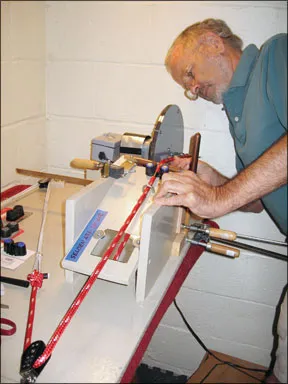
Photos by Jeremy McGeary
Typical applications are at the boom vang and mainsheet on sport boats and even larger cruising boats. Both are controls that may need to be eased in a hurry when the load on them is high. And a cam cleat is most likely to inflict a boat bite when a user is trying to ease or release a highly loaded line from it.
But theres no denying the usefulness of cam cleats, which is why Practical Sailor takes a look at them and their applications from time to time-we even developed a machine just for testing them: Doomsday.
Theres no telling what fate befell the original “Doomsday Machine” constructed by Practical Sailors backroom crew for the Aug. 1, 1997 report on cam cleats, but its successor (built for this round of tests) was no match for the current generation of cam cleats. Although the machine is not as tidy a photographic subject as it once was, it survived putting a selection of cam cleats through 1,000 cycles of pull, hold, and release.
What did we hope to discover by dragging lengths of New England Ropes 3/8-inch Sta-set over and over again through the tested cam cleats? Our principal goal was to learn in about five hours of testing what otherwise might take a boatowner a season of sailing: How much does a cam cleat beat up the line its working with and vice versa. Is the victim the cam cleat or the line?
We were able to test a few samples from a range of manufacturers side by side and make some objective and subjective observations about their physical and functional characteristics. To read more about what the Doomsday trials were able to tell us, see “How We Tested.”
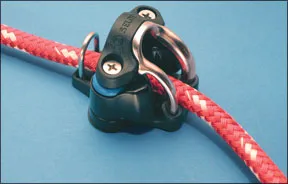
What We Tested
We requested manufacturers send us samples of production cam cleats designed to handle 3/8-inch line. In response, we received products from Harken, Selden, Ronstan, Garhauer, Schaefer, and Spinlock.
Both Harken and Ronstan have a long reach into the sailing market and compete fiercely for business from both racing and cruising sailors. This is good for consumers as the competition has led to improvements in products and a degree of standardization. Their cam cleats (those designed for similar applications) use the same size fasteners on the same spacing, so they are interchangeable.
Although Selden has been an original equipment manufacturer (OEM) supplier of spars and furling gear for decades, its a newcomer to the retail accessory market. It began manufacturing blocks, travelers, and other gear to provide one-stop shopping for boatbuilders like Hunter, Hallberg-Rassy, and Bavaria, and now is making its hardware, including cam cleats, available to boatowners through distributors.
Garhauer occupies a different niche and specializes in stainless-steel and aluminum hardware. It supplies a lot of OEM equipment to Catalina Yachts and to cruising sailors looking for bulletproof gear.
Schaefer has a long history of providing solid gear to both cruising and racing sailors, and items like cam cleats complement an extensive range of products including mainsheet systems.
Spinlock, headquartered in the UK, is probably best known for its line of deck hardware and accessories, but it also manufactures safety gear for performance sailors.
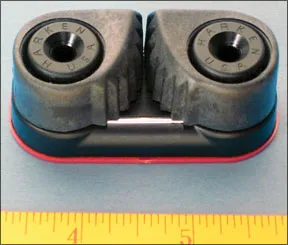
Once you trip a line out of the cleat, you are left holding a heavily loaded line, making these devices best suited for use on dinghies or smaller keelboats. On larger boats, they are acceptable for applications where they are not subjected to loads higher than a normal person can control (about 50 pounds).
Among our test products, the lightest safe working load (SWL) specified was 200 pounds. A line loaded that heavily would make short work of several layers of skin if you were to attempt to hold it or simply werent expecting the heavy load. Manufacturers list SWL specs to give users an idea of what the cam cleat can handle in the event of an unforeseen overloading, not as a recommendation of what the cleat should be regularly subjected to.
Ronstan RF5010
The only test cleat with interchangeable cams was the Ronstan RF5010. Its cams can be swapped left to right to present fresh working surfaces once they become worn.
The “neck” in the line (an indentation at the point where the line was held stationary in the cam)was barely noticeable through 500 cycles, after which it was noticeable. A trace of fuzzing appeared at 500 cycles and was more pronounced at 1,000.
Bottom line: This is, overall, a gentle cam cleat. Its available with a range of different colored cores and with a raft of accessories: rope guides, fairleads, wedges, mounts, and bases.
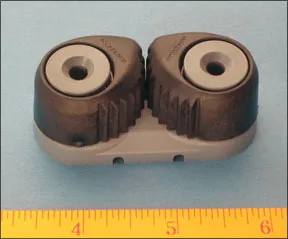
Harken 150 Cam-Matic
The Harken cam cleats are complemented with an array of extras to adapt them to any task on the boat. One of the selling points Harken touts with the 150 is that unlike most other cam cleats on the market, users can capture a line by simply dropping it down into the cams, rather than having to pull it through the cam.
The 150s hard-kote anodized aluminum cams make this the heavier of the Harken cam cleats tested. They feel very smooth and are indeed gentle on the line. The neck became definite at 500 cycles and the fuzz at 750 cycles.
Bottom line: This is a good choice when durability is a higher priority than saving weight.
Harken 365 Carbo-Cam
Interestingly, this lightweight cleat with carbon-fiber reinforced cams made a definite neck at 100 cycles, but it never became noticeably more pronounced even at 1,000 cycles. Fuzz wasnt noticeable until 500 cycles and was still barely noticeable at 1,000 cycles.
Bottom line: We recommended the 365 for racing boats where the goal is minimum weight. It doesn’t look as though it would destroy expensive line, and at $23, its not going to break the bank either.
Selden 433-301-01
The 301 has cast-aluminum cams and base. The literature says its hard anodized, but the finish on the pre-production sample appeared to be powder coated. The coating suffered no ill effects, and the cleat was kind on the test rope.
The neck became barely noticeable at 250 cycles and remained only definite at 1,000 cycles. Fuzz, too, was inconsequential, being only barely noticeable at 50 cycles and remaining the same through 1,000 cycles. This kind demeanor was reflected in the pinkie test.
Selden sent a selection of accessories with its sample cleats, emphasizing the companys intent to join the fray with those already well entrenched.
Bottom line:It weighs a little more than the composite models but its kind on line and inexpensive, so its a good option for the boatowner looking for a general-purpose cam cleat.
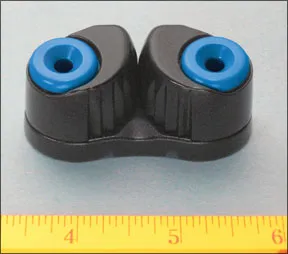
Selden 433-201-01
Seldens 201 and 301 are identical-as far as we can see-in everything except construction material. The 201 is carbon-fiber-reinforced polyetherimide, which is supposed to be resistant to heat build-up, for example when a long line is pulled through it very quickly.
The 201s neck feature went from definite at 100 cycles to prominent at 1,000 cycles while the fuzz was barely noticeable at 250 cycles but was prominent at 750 cycles. Why the 201 was so much harsher than the aluminum 301 was a puzzle to testers. The pinkie test shed little light, but the surface of the composite used in the 201 does feel rougher and perhaps is significantly so at the fiber scale.
Interestingly, the relative harshness on the line between the aluminum and composite examples is opposite that found with the Harken products.
Bottom line: At half the weight and about $10 less than its aluminum brother, the 201 is worth considering.
Garhauer
Garhauers products, big on stainless steel and light on composites, may look less fashionable than some others on the market, but the companys approach is a little different, too, in that it caters more to the cruising market. Garhauer offers an unconditional 10-year warranty on gear that certainly looks bulletproof.
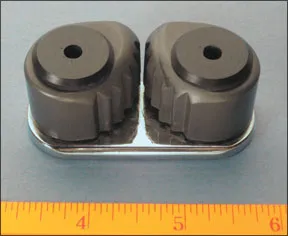
For the cams, Garhauer went to a 60-61 T6 aluminum extrusion. This is the same grade of alloy used for spars, and its free of the microscopic pores that result from casting. Its anodized surface should therefore last longer. The base is stainless steel.
Both neck and fuzz were barely noticeable until 500 cycles, when they were both definite. At 1,000 cycles, both were pronounced.
After wed completed the testing, Bill Felgenhauer of Garhauer sent two more cam cleats for us to test. In his own testing, hed observed that smaller lines tended to be gripped toward the points of the cams and figured that, to ensure the line would be held in the middle of the cams, he needed two models to handle line diameters from a quarter-inch to a half-inch. The cams are made from the same extrusion, and he adjusted them by drilling the pivot hole in a sightly different place (CNC machining is a wonderful tool.) These were the third generation hed provided for this test, but the company continues to improve on its cam cleats and most recently reduced spring tension by 30 percent over the one we tested.
Bottom line: While the test data presented here may not accurately represent the Garhauer cleats on the market when this review is published, the indications are this is a worthy complement to the Garhauer line, and its price and warranty deserve a look from the serious sailor. It gets the PS Budget Buy.
Spinlock PXR0810/T
The Spinlock PXR is a rather different animal. The line feeds through a fixed-entry lead and an exit lead that pivots vertically. Between them, the cams are one above the other: a fixed cam on the bottom and a pivoting cam on the top. The top cam releases completely when the tail of the line is lifted to pivot the exit lead upward and re-engages when the tail is pulled downward to flip the exit lead down. You can also operate the release by stepping on the top of the body, which is very handy in some scenarios but not so helpful when caused by inattentive crew scrambling to get to the new high side of the boat.
All these lockings and unlockings are accompanied by satisfying clicks from the spring-loaded mechanism, but for many simple applications, the device seems to have a lot of moving parts. However, by itself, it accomplishes several auxiliary tasks that would require add-ons with the other cam cleats tested.
Spinlock developed the first PX about 10 years ago as a device that would work like a cam cleat in many respects but that could be released under load. The T-shaped base has the same mounting hole geometry adopted by Harken, Ronstan, and the others. Full-diameter 3/8-inch line (a little larger than 10 millimeters) is a tight fit, and a sloppily hot-knifed end will not pass through the fairleads.
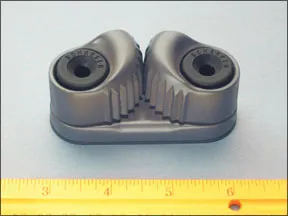
From an observers standpoint, the PXRs performance on Doomsday was boring. A barely noticeable neck and no fuzz were observed at 100 cycles and at 1,000 cycles.
Bottom line: The PXR was the kindest cleat of all those tested and, while its not an exact replacement for a “standard” cam cleat, the fact it can be released under load is a big bonus. Although its the most expensive in the test group, we recommend it for specialized uses.
Schaefer 70-27 Fast Entry
This is a relatively new product for Schaefer, and it tops out a hardware line with two smaller models, which likely would have been a better comparison for this head-to-head test. The 70-27 is a big cam cleat with a SWL of 500 pounds. On a racing boat where self-tailing winches are eschewed because of their weight, a robust cam cleat like this one might be found holding the tail of a control line whose load is held by a winch.
In the test, the 70-27 had formed a definite neck in the line at 100 cycles and a pronounced one at 250 cycles. However, no sign of fuzz appeared at any time. This could be due to the sheer size of the device, though the tops of the cams do have an exaggerated and very smooth entry lip.
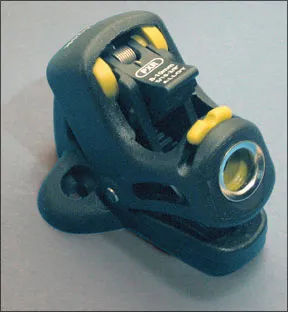
Bottom line: The Schaefer lives up to its “fast entry” description and doesn’t scuff up the line, so its a definite contender and an appropriate complement to the Schaefer line.
Conclusions
The models tested are just a sampling of the range of cam cleats offered in various sizes and materials. Most makers offer accessories-mountings, wedges, swivel bases, and fairleads-for adapting the products to deck and rig arrangements.
Price isn’t much of an issue here. Most of the devices are in the $20 to $30 range. For pure squeeze for the buck and a 10-year warranty, its hard to look past the $18 Garhauer, the PS Budget Buy.
A racing sailor, who probably uses cam cleats more frequently than a cruiser and who is keen to keep weight down, should consider a composite model. Of the tested cam cleats, the one that appears least likely to gnaw through expensive line is the Harken 365. At $23, its not going to break the bank, either, so we recommend it for the weekend warrior. The aluminum Selden 301 was also very gentle and only a few grams heavier. Its the PS Recommended cam cleat for general use.
At the other end of the spectrum, a cruiser who is more concerned about durability should consider the Garhauer. On the basis that bulk is everything, the Schaefer 70-27 could fulfill the same role, but wed likely opt for one of the companys smaller models.
The Spinlock is in a class of its own in that the line is always in control. This could well give it an advantage in applications such as in a mainsheet setup, when a line sometimes has to be released in a hurry. Its comparatively pricey, but it gets our pick for specialized applications.


































Excellent review for pros & cons, in particular the ability to release a line under high tension. However, trying to link each photo to it’s description is very frustrating. At least one photo, that of the Spin lock PRX is completely out of sequence.
Once again, someone at PS needs to do review before publishing!
Thanks Steve. I’ll get the web team to fix this. In the meantime, the print PDF version has the correct information.